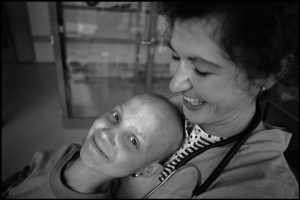Research over the last three decades has yielded many potential health impacts from the Chernobyl accident. These health impacts are due to exposure to radioactive materials and the psychological trauma associated with the Chernobyl accident (UN Chernobyl Forum Expert Group “Health” 2006; World Health Organization Radiation and Health Team 2016). But, among various governing bodies, scientific researchers and medical professionals, there is debate about the extent of adverse health effects following the Chernobyl disaster. In a comprehensive report of Chernobyl related health effects, the United Nations (UN) Chernobyl Forum found that radiation exposure resulted in increased risk of thyroid diseases, thyroid cancer, cataractogenous, cardiovascular disease, immunological impairment, and infant mortality (UN Chernobyl Forum Expert Group “Health” 2006). The World Health Organization (WHO) has also reported increased rates of cancer and other diseases in people exposed to radiation from Chernobyl. Although debate over the extent of long-term health effects of the Chernobyl accident remains, research continues to focus on thyroid cancers as well as other cancers and genome damage.
Of particular significance has been the increased incidence of thyroid cancers in people exposed to iodine-131 (I-131) after the accident. Children and adolescents in Belarus, Ukraine, and Russia were most severely affected by exposure to I-131 following the accident. I-131 contaminated fresh milk in the region surrounding Chernobyl, and children and adolescents consumed greater proportions of milk than adults. Additionally, children have smaller thyroids, so the I-131 dose to thyroid mass ratio was highest in children. Studies of approximately 26,000 children and adolescents exposed to I-131 in Belarus and Ukraine found increased incidence of thyroid cancer compared to the general population (Hatch and Cardis 2017, 1048). More recent studies have shown that thirty years after the Chernobyl accident, those who were children at the time of radionuclide exposure continue to have a disproportionally high risk of developing thyroid cancer (Weiss 2018, 59). Research does not suggest significant increases in thyroid cancer rates among adults who were not directly involved in the clean-up process, but there have been significant increases in thyroid cancer in people who were present during clean-up efforts and/or the first response to fires at Reactor 4 (Weiss 2018). In Belarus there was a 1925% increase among females and a 775% increase among males in thyroid cancer cases between 1970 and 2001 (Mahoney et al. 2004). Moreover, recent work in Ukraine has indicated that Caesium-137, another radionuclide, was still present in milk at higher levels than the Ukrainian government deems “permissible” for adults and children as of 2016 (Labunska et al. 2018). Overall, the Chernobyl nuclear accident has left those exposed to radiation with increased rates of thyroid cancer, and making radiation exposure an on-going issue, radionuclides continue to persist in the environment.

Thyroid cancer has increased drastically among those exposed to radiation from the Chernobyl accident in Belarus (Mahoney et al. 2004).

Persistence of Caesium-137 radionuclides in milk. Cs-137 levels remain above safe levels in Ukraine as of 2016 (Labunska et al. 2018).
Other health maladies have been associated with exposure to radiation released from Chernobyl, but identifying the relationship between disease and radionuclide exposure is difficult due to confounding risk factors. Prior to the Chernobyl accident certain regions in Ukraine and Belarus suffered from malnutrition and frequent infections, both of which can increase risk of developing other health conditions. Among people living in contaminated regions, there has been an increase in Down syndrome, breast cancer, and genome damage. Additionally, liquidators and young children (0-5 years when the accident occurred) have experienced increased incidence of leukemia (Fucic et al. 2016). Liquidators and children are the two most at risk groups because liquidators were exposed to extremely high levels of radiation and children are more severely affected by radiation due to their small body size. Both of these groups have had significantly higher rates of birth defects than the general population, and children exposed to high doses of radiation have higher frequencies of genome damage (Fucic et al. 2016). Ultimately, the full extent of nuclear radiation is not completely understood, but the Chernobyl accident has imposed long lasting health effects on people living in the surrounding regions and involved in clean-up efforts.


